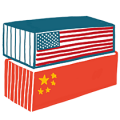

US tax cuts might inspire more capital outflows from China
With little room for tightening, Beijing lacks good options to prevent a return of capital flight. China cannot afford to match the US policy changes as lower tax rates and higher interest rates would further drive up budget deficits and debt.
The US Republicans’ tax cuts, which recently made it through Congress and will be implemented this year, will have deep and far-ranging consequences. They will be felt even in China. The cuts will be the largest in 30 years, bringing the corporate tax rate down from 35 per cent to 21 per cent, 4 percentage points below the rate in China. The combination of lower corporate tax and expected interest rate rises by the Federal Reserve will cause investors from all over the world to chase higher returns in the United States.
While many countries now fear an exodus of capital, this will be especially problematic for China. Capital flight will cause the exchange rate to depreciate against the US dollar, weakening China’s external purchasing power and threatening to throw its overleveraged financial system into crisis. In 2016, China experienced capital flight serious enough to force the People’s Bank of China (PBoC) to spend a quarter — 1 trillion USD — of its foreign exchange reserves to stave off the depreciatory pressure on the exchange rate.
Why it might get harder for China to stem capital outflow
Eventually, capital controls and surprisingly strong economic growth reduced the outflows. But the underlying reasons why capital was seeking to leave — a cooling economy, limited investment options and the likely prospect of rising taxes to refinance the financial system — are still unresolved. Under less favorable conditions capital controls might not be enough to keep the water in the leaky tub of the Chinese economy once the US tax cuts hit.
There are two ways in which a country can ensure that more money flows into the system than leaves it: either capital must be locked in, or investors must be persuaded to invest in the country. China is already doing a bit of both. However, neither option is particularly attractive.
The reasons for this lie in the financial system. The combination of slowing growth and a debt-to-GDP ratio of 255 per cent ensure that easy solutions are hard to come by.
In the past, China has been quite successful at locking capital in by using capital controls. But such controls have limitations. The most obvious is that it is simply impossible to catch all attempts to illegally take money out.
The second problem is that not all wealth within China is held by the Chinese. Some is held by foreign investors. By making it difficult to repatriate profits overseas, China risks deterring foreign investment and depriving its economy of capital inflows.
There are a number of ways to render the climate for investment more attractive. China has announced new tax deductions for foreign companies that reinvest their profits in sectors of the Chinese economy that are promoted by the government. But such adjustments are minor compared with sweeping tax cuts and higher interest rates, factors that affect what investors care about the most: returns.
China can't afford lower taxes or higher interest rates
So why can’t China simply match the US policy changes? For one, China cannot afford to increase its budget deficits, as it needs to avoid a further build-up of debt. Local governments have been boosting growth by investing in infrastructure projects, often funded by semi-private financing vehicles. If taxes were lowered, local governments would be forced to borrow even more to ensure growth remains at acceptable levels. Large-scale tax cuts are not an attractive option for China’s policymakers.
Neither is raising interest rates. The fact that the reversed repo rate (the controlling rate) was increased by only 0.05 percentage points during the ongoing deleveraging campaign shows how reluctant policymakers have been to increase rates.
Smaller Chinese banks and financial institutions do not take in large amounts of deposits and instead often borrow short-term on the interbank market to invest in long-term projects. Given that the level of incremental GDP generated by one incremental unit of credit has fallen sharply in China in the past few years, this practice must be very widespread.
These institutions’ investments do not always perform, which leads to the need to refinance or renegotiate short-term debt at higher rates. Rising interest rates could easily turn these institutions insolvent, potentially triggering an economy-wide crisis. It is not surprising that the PBoC has been so reluctant to raise rates.
Once the US tax cuts and further interest rate rises are implemented, the increased returns on the other side of the Pacific will probably cause Chinese capital flight to make a comeback. The last time around, strict capital controls coupled with a strong economy and globally low rates were enough to halt the trend. But this time things might play out differently.
The underlying issues that caused capital flight in the past are unresolved and, this time, returns on investment in other countries are not as low. Responding to the US policy changes without rocking the boat is likely to be extremely difficult.
Beijing will probably try to manage the problem through a series of small policy changes, ranging from mini tax cuts to targeted capital controls to further tiny rate rises. The question is, will micromanagement be enough this time?
This article was first published on the Financial Times' beyondbrics blog on January 22, 2017.
